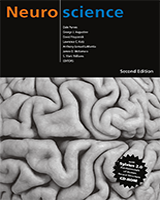From: Cutaneous and Subcutaneous Somatic Sensory Receptors

NCBI Bookshelf. A service of the National Library of Medicine, National Institutes of Health.
| Receptor type | Anatomical characteristics | Associated axonsa (and diameters) | Axonal conduction velocities | Location | Function | Rate of adaptation | Threshold of activation |
|---|---|---|---|---|---|---|---|
| Free nerve endings | Minimally specialized nerve endings | C, Aδ | 2–20 m/s | All skin | Pain, temperature, crude touch | Slow | High |
| Meissner's corpuscles | Encapsulated; between dermal papillae | Aβ 6–12 μm | Principally glabrous skin | Touch, pressure (dynamic) | Rapid | Low | |
| Pacinian corpuscles | Encapsulated; onionlike covering | Aβ 6–12 μm | Subcutaneous tissue, interosseous membranes, viscera | Deep pressure, vibration (dynamic) | Rapid | Low | |
| Merkel's disks | Encapsulated; associated with peptide- releasing cells | Aβ | All skin, hair follicles | Touch, pressure (static) | Slow | Low | |
| Ruffini's corpuscles | Encapsulated; oriented along stretch lines | Aβ 6–12 μm | All skin | Stretching of skin | Slow | Low | |
| Muscle spindles | Highly specialized (see Figure 9.5 and Chapter 15) | Ia and II | Muscles | Muscle length | Both slow and rapid | Low | |
| Golgi tendon organs | Highly specialized (see Chapter 15) | Ib | Tendons | Muscle tension | Slow | Low | |
| Joint receptors | Minimally specialized | — | Joints | Joint position | Rapid | Low |
In the 1920s and 1930s, there was a virtual cottage industry classifying axons according to their conduction velocity. Three main categories were discerned, called A, B, and C. A comprises the largest and fastest axons, C the smallest and slowest. Mechanoreceptor axons generally fall into category A. The A group is further broken down into subgroups designated α (the fastest), β, and δ (the slowest). To make matters even more confusing, muscle afferent axons are usually classified into four additional groups—I (the fastest), II, III, and IV (the slowest)—with subgroups designated by lowercase roman letters!
From: Cutaneous and Subcutaneous Somatic Sensory Receptors

NCBI Bookshelf. A service of the National Library of Medicine, National Institutes of Health.